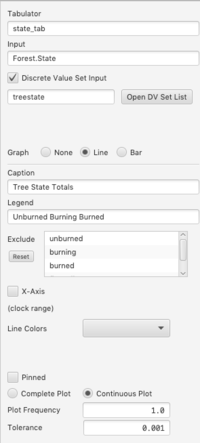Difference between revisions of "Component Guide IV: Plugins"
| Line 9: | Line 9: | ||
See ''Firespread'' in the model library for an example using the Tabulator. | See ''Firespread'' in the model library for an example using the Tabulator. | ||
<br clear="all"> | <br clear="all"> | ||
[[File:tabprop1.png | | [[File:tabprop1.png|200px|thumb|right]] | ||
===Properties=== | ===Properties=== | ||
*'''Size'''. The number of possible states. This determines the number of output pins on the Tabulator. | *'''Size'''. The number of possible states. This determines the number of output pins on the Tabulator. | ||
*'''Base Value'''. States run from Base Value through Base Value + Size - 1. | *'''Base Value'''. States run from Base Value through Base Value + Size - 1. | ||
<br clear="all"> | <br clear="all"> | ||
Revision as of 16:21, 14 October 2019
Plugins are additional components that provide special functionality. In future releases it will be possible for the user to create and add plugins of his/her own creation (a plugin writers guide is planned). We also anticipate future releases with plugin sets designed for specific application domains.
The current release of Numerus includes 4 plugins, which are described below.
Tabulator
A tabulator is a special component that works with an aggregator in which a constituent (agent, cell, node) has either a Discrete State component or uses a Sequence to model a discrete state. The tabulator counts the number of elements in each state and outputs the totals on separate pins, primarily for graphing or displaying in a table. The states are expected to be consecutive numbers such as 0, 1, 2, etc. The sequence need not start at 0. (The sequence will, or course, always start at 0 if a Discrete State component is used.)
See Firespread in the model library for an example using the Tabulator.
Properties
- Size. The number of possible states. This determines the number of output pins on the Tabulator.
- Base Value. States run from Base Value through Base Value + Size - 1.

